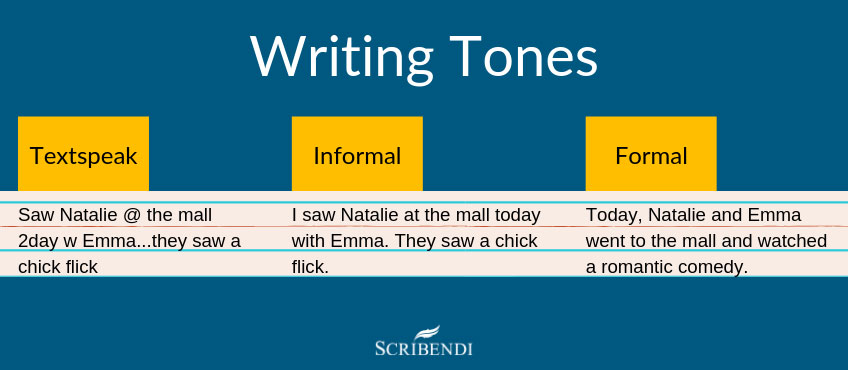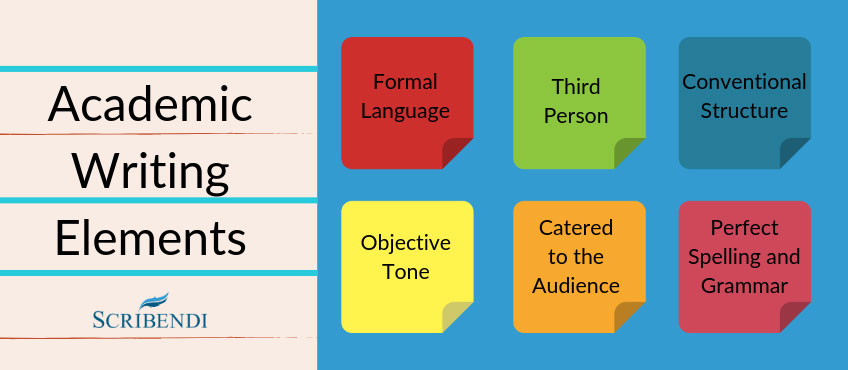Written by Scribendi
Have you ever wondered how academic writing stacks up against different styles of writing? If you have, then you're in good company, as many curious minds have pondered that same distinction. Let's get to it!
Formal Language versus Informal Language
Academic writing should use formal language that minimizes the use of contractions and colloquialisms and avoids slang terminology whenever possible. Casual language should only be used for emphasis.
Further, academic writing generally does not employ first person pronouns like "I" or "we," but different styles of writing do offer varying degrees of flexibility when it comes to the use of language, with a diverse range of informal elements sanctioned among different styles of writing.
Check out the image below to further explore the differences between textspeak, informal language, and formal language!

Structure and Form
Style guides like the Publication Manual of the American Psychological Association (APA) and the Chicago Manual of Style are quintessential resources for scholars engaging in academic writing, with different style guides used for different fields of academia. These style guides standardize how references should be presented and how a document should be formatted, considering things like the margins, headings, typeface, and a myriad of other elements; some guides even prescribe the kind of language to be used for various circumstances encountered most frequently within the field.
All forms of academic writing will employ a structure that should allow the information presented to flow logically from one section to the next, regardless of the segments or formatting details used according to different styles of writing. For example, a scientific research article will typically include sections for the abstract, introduction, methods, analysis, results, and conclusions, whereas a paper written for the humanities will use a drastically different framework that can vary between artistic disciplines.
Different styles of writing contain various essential structural elements. This means that some styles, such as creative writing, grant significantly more freedom to the author than other styles, such as the style used for writing engineering documents.
Tone
The tone used to communicate ideas will significantly affect how readers interpret those ideas. It's vital that different styles of writing adopt different tones appropriate for the respective target audiences.
It's especially crucial within academic writing to eliminate all personal biases, both explicit and implicit. Academic writing must display objectivity. It's often best that academic writing avoids rhetorical tactics, like sweeping generalizations and emotional arguments, as this will ensure the highest degree of objectivity expected from academic writing.
At its core, academic writing should be clear, succinct, and objective; the exact criteria for these qualities differ among different styles of writing, but without these elements, the credibility of academic writing is often shaky.
Audience
The tone, language, and formality of academic writing will all depend on the target audience. As such, the target audience is a crucial consideration for effective academic writing.
In an academic setting, your audience could comprise researchers, professors, and/or experts in the field, but a casual piece might target your family and friends. The way we speak to figures of authority is very different from how we speak to siblings or friends, and communicating with these different groups when writing is no different; the word choices used in academic writing should suit the audience just as much as a person's vocabulary and gestures might shift for face-to-face communication according to these different groups.
For example, when the public is the intended audience for a piece of academic writing, it's probably a good idea to use simple language to explain any tricky terms used in the document. You might even consider substituting the academic jargon for another phrase more easily understood by the masses. This is true for all different styles of writing. The audience needs to understand what has been written!
If you're uncertain whether a particular term might be appropriate for your audience, try consulting a friend who is unfamiliar with the topic. This should clearly indicate how easy it might be for the average person to understand the concept.
Conclusion
The following piece of advice applies to all different styles of writing: leave time to edit! Regardless of the document, your work should be entirely free from errors. Proofreading for things like grammatical mistakes and punctuation errors and editing for elements such as the word choices and sentence structures will ensure that the writing is cohesive and clear. Further revision will ensure that unsightly grammatical errors and embarrassing typos never appear before the unforgiving public eye.
Have a peek at the image below to review the key aspects of academic writing (you can even download the image for reference). Once these elements have been nailed, you will have officially become a master of academic writing.

Image source: AboutImages/elements.envato.com
Make Sure Your Academic Writing Follows Conventions
Hire an Expert Academic Editor, or Get a Free Sample
About the Author
Scribendi’s in-house editors work with writers from all over the globe to perfect their writing. They know that no piece of writing is complete without a professional edit, and they love to see a good piece of writing turn into a great one after the editing process. Scribendi’s in-house editors are unrivaled in both experience and education, having collectively edited millions of words and obtained nearly 20 degrees collectively. They love consuming caffeinated beverages, reading books of various genres, and relaxing in quiet, dimly lit spaces.










